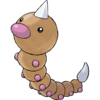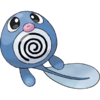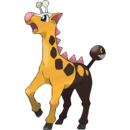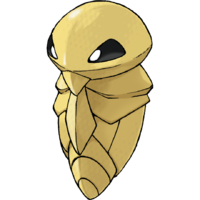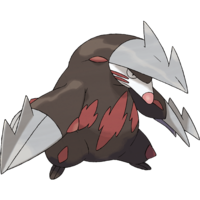List of unused Pokémon and character designs
These are Pokémon and characters that were just a few of many different designs that Game Freak created. Only a few were added, and even those often went through redesigns before making it into the final product.
Unreleased Pokémon
Capsule Monsters designs
| Debut | Capsule Monsters |
|---|
Nothing is known about this creature other than its number, #124, the same as Jynx's. This number is also the index number of Caterpie. It also resembles a cat.
| Debut | Capsule Monsters |
|---|
Nothing is known about this creature other than its number, #211, the same as Qwilfish's.
| Debut | Capsule Monsters |
|---|
| Debut | Capsule Monsters |
|---|
Nothing is known about Godzillante. It is shown to be breathing fire. As its name implies, it may have been based on Godzilla. Godzillante shares a resemblance to a fake Pokémon toy shown in the Pokémon Pocket Monsters manga Volume 1 (p. 107).
Nothing is known about Gorillaimo. Its hat could be a reference to the character Ninten from the Ape Inc. game, Mother. It also resembles the Nintendo character Donkey Kong. Gorillaimo could also be based on King Kong. Later generations have introduced many ape-based Pokémon.
| Debut | Capsule Monsters |
|---|
| Debut | Capsule Monsters |
|---|
Pokémon designs
The only known information about this creature is its name and image. In the playable alpha demo of Gold and Silver, its National Pokédex number was 212 and knew the moves Growl, Water Gun, and Tackle. Despite its Pokédex numbering, it was the Water-type starter in said demo. Since it resembles a seal, some fans believe it may have inspired Spheal's design, but they are no more similar than either of them is to Seel.
Like Kurusu above, its name and image are all that is known about it. Its name is a combination of 炎 honō (flame) and 熊 kuma (bear). In the alpha, it was the Fire-type starter and knew the moves Ember, Scratch, and Leer. Given its name refers to it as a bear, some fans believe it could have been an early version of the Teddiursa evolution family.
| Debut | Game Freak interview |
|---|
| Debut | Game Freak interview |
|---|
A Pokémon based upon a rabbit with a flower on its nose was designed by Hironobu Yoshida, but was scrapped due to it not making sense in its environment. It was revealed in an interview with Nintendo Life.
| Debut | Game Freak interview |
|---|
Flygon has had the potential to have a Mega Evolution since XY, but Game Freak was unable to complete a design and so it was dropped from consideration. It was revealed in an interview conducted by the magazine Nintendo Dream. An English translation was provided by PokéBeach.
| Debut | Game Freak interview |
|---|
Pikachu's original illustrator, Atsuko Nishida, and Pokémon designer Ken Sugimori revealed the lost evolution in an interview with Japanese newspaper Yomiuri on May 2, 2018, and Siliconera translated the article into English on May 3. Originally intended to be Raichu's evolution, the design was to include fangs and a pair of horns. Sugimori cited game balance issues, which led to the design being omitted from the games.
An unused Generation I Pokémon design, revealed in the 2018 educational manga "Satoshi Tajiri: The Man Who Created Pokémon". It was shown on a page discussing a poll in which the staff of the game would vote for their favorite Pokémon before including some of them in the final games. It appears to be based on a deer. It is numbered "56".
An unused Generation I Pokémon design, revealed in the 2018 educational manga "Satoshi Tajiri: The Man Who Created Pokémon". It was shown on a page discussing a poll in which the staff of the game would vote for their favorite Pokémon before including some of them in the final games. It appears to be based on a crocodile with large eyes and what appears to be long 'hair'. It is numbered "62".
An unused Generation I Pokémon design, revealed in the 2018 educational manga "Satoshi Tajiri: The Man Who Created Pokémon", inspired by cacti. It was shown on a page discussing a poll in which the staff of the game would vote for their favorite Pokémon before including some of them in the final games. It is numbered "67".
An unused Generation I Pokémon design, revealed in the 2018 educational manga "Satoshi Tajiri: The Man Who Created Pokémon". It was shown on a page discussing a poll in which the staff of the game would vote for their favorite Pokémon before including some of them in the final games. It appears to be based on a shark, in particular those with a pointed head. It is numbered "68".
An unused Generation I Pokémon design, revealed in the 2018 educational manga "Satoshi Tajiri: The Man Who Created Pokémon". It was again part of the contest, shown in the manga on a board. Not much is known about this Pokémon. It appears to be based on an elephant.
Altered Pokémon
| Debut | Capsule Monsters |
|---|
- Main article: Gengar (Pokémon)
- Main article: Nidorino (Pokémon)
An early version of Gengar and a creature with traits of Nidorino, Gyarados, and Feraligatr.
- Main article: Weedle (Pokémon)
An early version of Weedle. This was one of several Pokémon sprites shown on Game Freak's official Japanese website circa 1997.
The evolution of Kokana. This was one of several Pokémon sprites shown on Game Freak's official Japanese website circa 1997. It was replaced by Kakuna, although they share few similarities.
- Main article: Poliwag (Pokémon)
An early version of Poliwag. This was one of several Pokémon sprites shown on Game Freak's official Japanese website circa 1997.
- Main article: Poliwhirl (Pokémon)
- Main article: Poliwrath (Pokémon)
An early version of Poliwrath. This was one of several Pokémon sprites shown on Game Freak's official Japanese website circa 1997. Notably it is wearing a crown, similar to the King's Rock necessary to evolve Poliwhirl into Politoed.
| Debut | Game Freak interview |
|---|
- Main article: Dragonair (Pokémon)
An early version of Dragonair. This was one of several Pokémon sprites shown on Game Freak's official Japanese website circa 1997.
- Main article: Ledyba (Pokémon)
An early version of Ledyba. Unlike the final design, its abdomen is black rather than cream-colored, it only has four limbs, and it appears to be headless, with its eyes and antennae attached to its body.
- Main article: Marill (Pokémon)
An early version of Marill. While they are recognizably similar, they are visually quite different. The pink/purple color is the main difference as well as the notably missing large ears. It also sports a thinner body, more resembling a rodent, but does not sport Marill's erratic tail pattern, though with this being a concept art, small details were most likely not a concern at the time.
- Main article: Hoppip (Pokémon)
- Main article: Girafarig (Pokémon)
- Main article: Qwilfish (Pokémon)
Bukū's name is derived from fugu, the Japanese word for blowfish. It is most likely an early version of Qwilfish. Notable differences between Qwilfish and this pre-release version are the colors, and shape of the tail. Notably, the shape of the tail does appear slightly similar to the length of the tail in Qwilfish's Generation II back sprite. However, this was just an error and no other generation shows Qwilfish's tail that short.
- Main article: Raikou (Pokémon)
- Main article: Suicune (Pokémon)
This artwork resembles Raikou and Suicune. It was illustrated by Muneo Saitō, who was also the designer of the legendary beasts, including Entei.
- Main article: Torchic (Pokémon)
This early version of Torchic shows its lower body covered by an eggshell, with the fluff going all around its neck and wing-shaped ears. The other early design is nearly identical to the current Torchic, aside from the large floppy ears, and a flame-shaped marking on the back of its head, rather than the final design's flame-shaped feathers on top of its head.
- Main article: Blaziken (Pokémon)
- Main article: Latias (Pokémon)
Sometimes referred to as Latiaziken or Latiken by fans, this early image from Pokémon Ruby and Sapphire depicts a creature with traits of both Latias and Blaziken. In appearance, it more closely resembles Blaziken, but some features are more similar to Latias, such as its size. Some features resemble neither Pokémon, such as the hands.
- Main article: Shellos (Pokémon)
- Main article: Gastrodon (Pokémon)
Prototype back sprites of Shellos and Gastrodon show another form for each. These forms are possibly leftovers from when Shellos and Gastrodon were planned to be in Generation III. Shellos's sprite is pink, like its West Sea variation, and seems to combine the western variation's head with the eastern variation's body. Gastrodon's sprite is brown and looks like its Western variation, but with more rock-like protrusions on its body.
Ken Sugimori: "Deino, Zweilous, Hydreigon. At first, these incorporated an army tank motif, and the marks that look like a conveyor belt on the upper part of Zweilous's legs are the remnants of that. Initially, they didn't work as designs and were basically 'put to sleep', however, a three-stage powerful Dragon-type family was ordered and they were resurrected."
Minor alterations
| Debut | Capsule Monsters |
|---|
- Main article: Blastoise (Pokémon)
- Main article: Staryu (Pokémon)
In this early depiction of a battle, Blastoise is shown without its signature water cannons. Originally, this picture was captioned "Karabajio VS. Mimii", which are not the names of any known Pokémon. Karabajio may be a reference to the Italian painter Caravaggio, which in turn may reference how the Teenage Mutant Ninja Turtles are named after Italian artists. It also may include "carapace".
- Main article: Kakuna (Pokémon)
The "arms" on Kakuna seen in its Red and Blue sprite are commonly mistaken to be a sprite error, as they are rarely shown in any other media. They have, so far, only been shown on its Red and Blue sprite and one of the Pocket Monsters Carddass Trading Cards. In most depictions since, Kakuna's arms are always tucked up against its belly, apparently unable to move.
| Debut | Game Freak Interview |
|---|
Pikachu's original illustrator, Atsuko Nishida, revealed the Pokémon's initial prototype resembled a daifuku (a round dessert) with ears in an interview with Japanese newspaper Yomiuri on May 2, 2018, and Siliconera translated the article into English on May 3. Its design basis changed to a squirrel to make it overly cuter, although the ear black tips are remnants of the initial concept.
| Debut | Capsule Monsters |
|---|
- Main article: Lapras (Pokémon)
This early version of Lapras is recognizably similar, but visually quite different. Lapras's curly ears are not present, and the underbelly coloration ends under the lower jaw instead of including it. There are also no visible appendages or tail, but that may be due to the water. However, it bears a striking resemblance to its Generation I back sprite. Also in the sketch is an early design of Red.
- Main article: Chikorita (Pokémon)
A demo released in 1998 showed that Chikorita's pre-release name was Happa (Japanese: ハッパ). Happa was previously mistakenly thought to be a prototype of Chikorita.
- Main article: Ampharos (Pokémon)
An early sprite of Ampharos shows a lack of coloring. Its tail and head lack the signature red coloring to them and its belly is the same color as the rest of its fur instead of white. Ampharos is shown with a shorter neck and it only has two rings around its neck instead of three.
- Main article: Bellossom (Pokémon)
Both early artwork of Bellossom and its Gold and Silver artwork show that it was originally to be a similar color to its other evolutionary relatives. This might have been changed to avoid another racial controversy, as the original Bellossom design appears similar to traditional Polynesian dress.
- Main article: Tyranitar (Pokémon)
This early version of Tyranitar is nearly identical to the design seen in the finalized Gold and Silver versions. It was shown alongside two unnamed Pokémon (seen in the section above) on the cover of a Japanese gaming magazine, where it was the only early design to become a released Pokémon. It has very few differences compared to the final version. Of these differences, the early Tyranitar design is more heavy-set, has a tan, rather than indigo, belly, has arms more reminiscent of Nidoking, and dozens of short spikes upon its back rather than a few long ones. It seems peculiar that Tyranitar was nearly completed at the time, but the other two featured Pokémon were never seen in their original designs.
- Main article: Treecko (Pokémon)
Concept art of Treecko shows numerous designs for the creature before the final one was decided. Many of these early sketches more closely resemble real geckos than the final product, which would later gain a more elongated head shape and a rounder nose.
- Main article: Groudon (Pokémon)
In its early design, its eyes were shaped differently, the positioning of the spikes on its body was slightly different, its overall shapes are much less sharp, its head details became much more elongated in the final version, and the weather trio's signature body patterns are not present.
- Main article: Excadrill (Pokémon)
In Excadrill's first appearance in a promotional video, its body was violet and its markings were mirrored and a different shade of red. However, it was changed to its current appearance in the next video it appeared in.
- Main article: Throh (Pokémon)
- Main article: Sawk (Pokémon)
According to interviews with Ken Sugimori in Nintendo Dream, during development, Sawk and Throh both had horns to look more like oni. However, these were replaced with eyebrows so as not to clash with Tornadus and Thundurus, who were originally designed to be red and blue, like Throh and Sawk.
- Main article: Stunfisk (Pokémon)
Stunfisk was originally designed with an anglerfish in mind, but became more like a flounder. It was also a Water/Electric type, but was changed to Ground/Electric to balance out the type spread of Pokémon.
An early version of Sawsbuck. This was shown at a convention featuring pictures and concept art from Pokemon Black and White. In an interview, it was said that Sawsbuck was created before the idea of seasons.
An early version of Clefairy was shown on a sprite sheet for Pokemon Red and Green. While it does look recognizably similar to Clefairy's final design, there are many differences, such as its horns and extremely enlarged eyes.
Unreleased characters
| Debut | Capsule Monsters |
|---|
Early Capsule Monsters artwork was shown in the book Satoshi Tajiri: A Man Who Created Pokémon, revealing an unnamed male character running a shop, or what would possibly become an early version of the Poké Mart. The character is almost bald, has long eyebrows and appears to be overweight. He is presented in a similar art style to the sumo enemies from Game Freak's debut title, Quinty (localized as Mendel Palace).
Revamped and enlarged versions of Mendel Palace's sumo sprites also appear in Ruby, Sapphire, and Emerald as overworld sprites which are believed to be unused.
- Main article: Leaf (game)
This art of a female character (with Squirtle) was featured on the cover artwork for the official strategy guide for Red and Green, as published by Shogakukan. A similar character appears several times in manga-styled instructions illustrated by Emiko Yoshino included in Pokémon papercraft sets (bottom). When Red and Green were later remade, players finally got the chance to use a female player character who was possibly based on this character.
In the Pokémon Adventures manga, a similar artwork appeared at the end of Volume 3 (right). The design of the character Green seems to have drawn inspiration from this unknown female character. After the release of FireRed and LeafGreen, Green donned the same outfit as the female player character in the fifth chapter of the manga.
This unnamed female Trainer art was revealed in a magazine prior to Generation II but never officially released. It is unclear who this Trainer was supposed to represent, be it a main character, a supporting character, or just an NPC. Visually, she has similarities to multiple Trainer classes. Her age and appearance make her appear similar to a Beauty or Cool Trainer, but her outfit is similar to a Lass or Picnicker. There is an object on her shirt that looks like what could have been a Gym Badge. This Badge has a rain drop on it, meaning she could have been a Water-type Gym Leader.
Hiding in the background of the same magazine as the female Trainer above was a male Trainer that was never used. As with the female Trainer, it is unclear If he was designed as a main character, or supporting character, or was simply representing a Trainer class. He has hints of multiple classes, such as a Tamer, Psychic, Juggler, Burglar, PokéManiac, Gambler and a male Rocket Executive. There is an object on his bandanna that looks like what could have been a Gym Badge. This Badge has a red diamond on it.






















